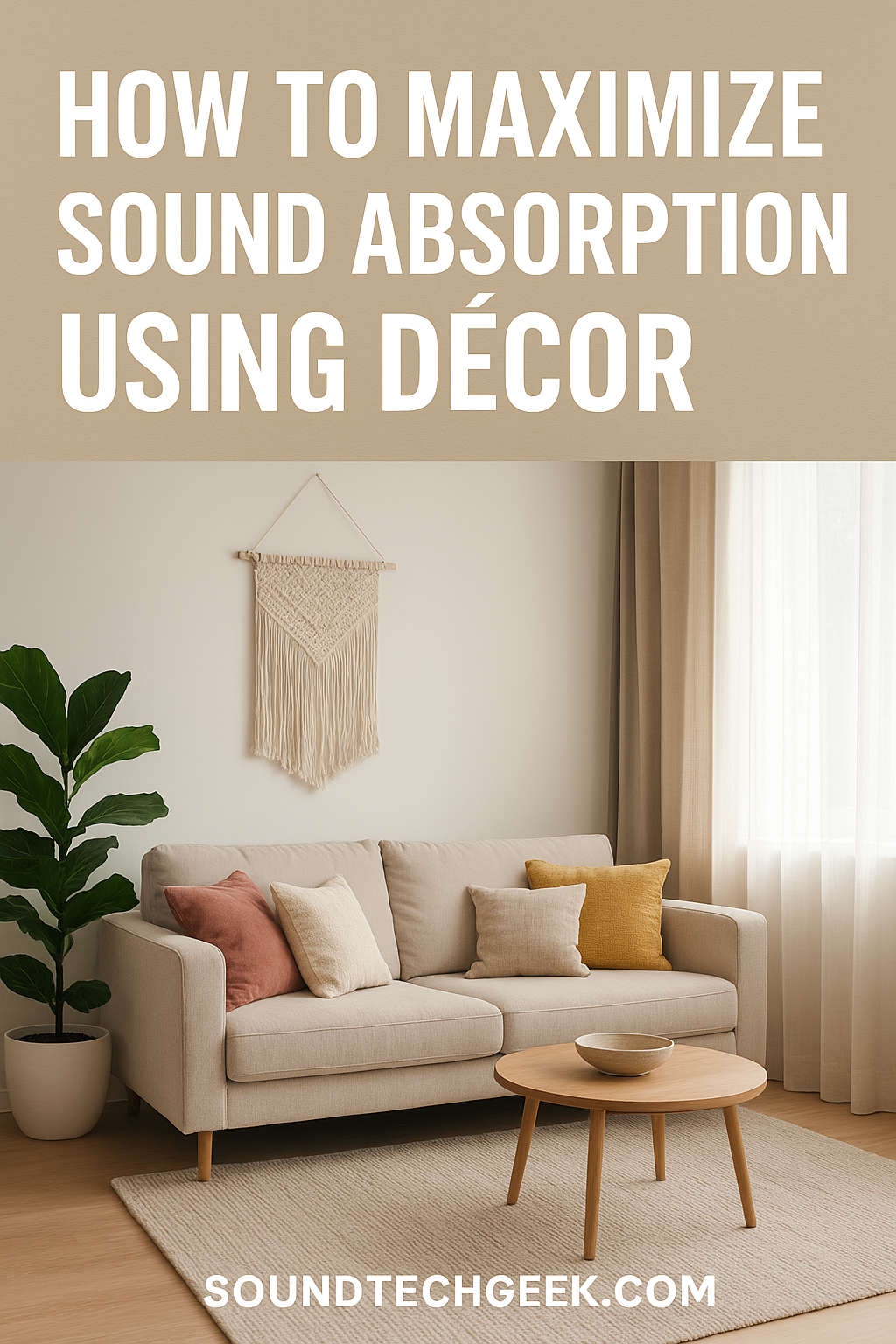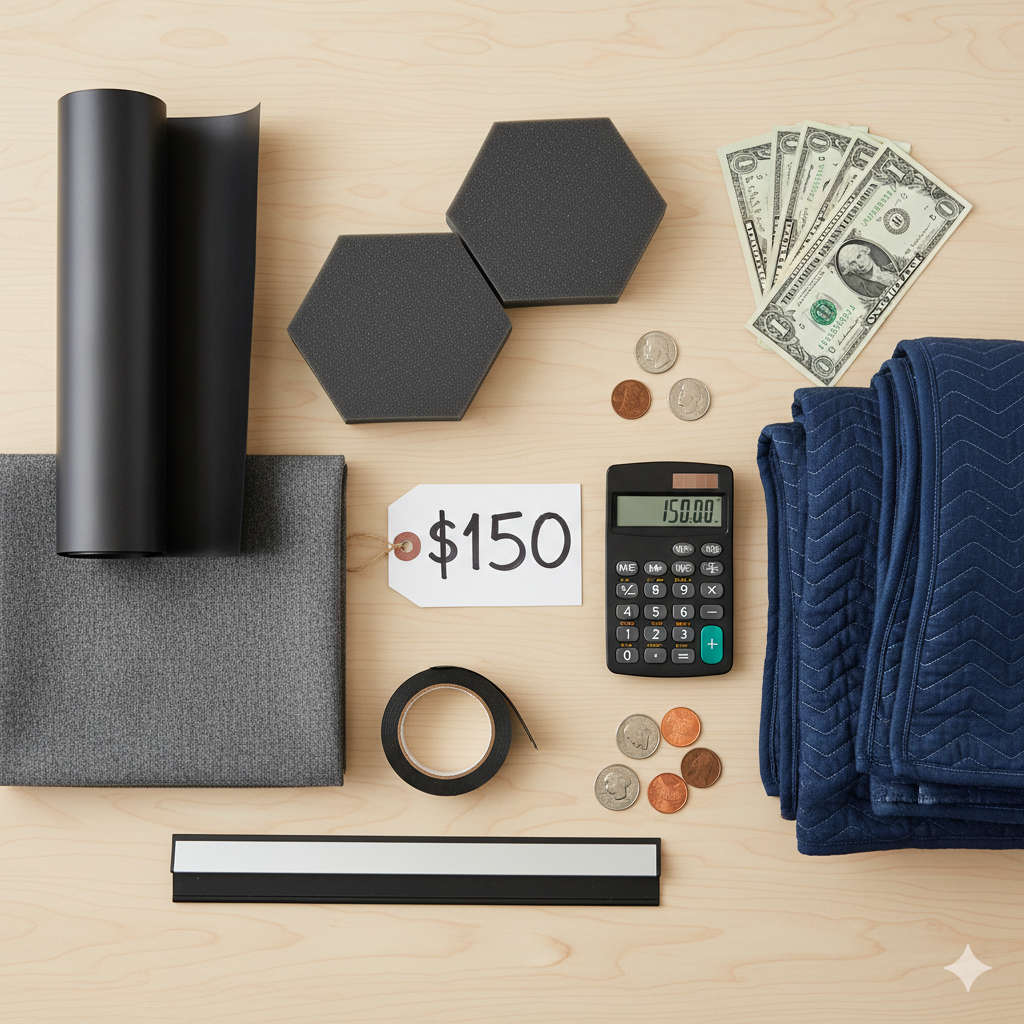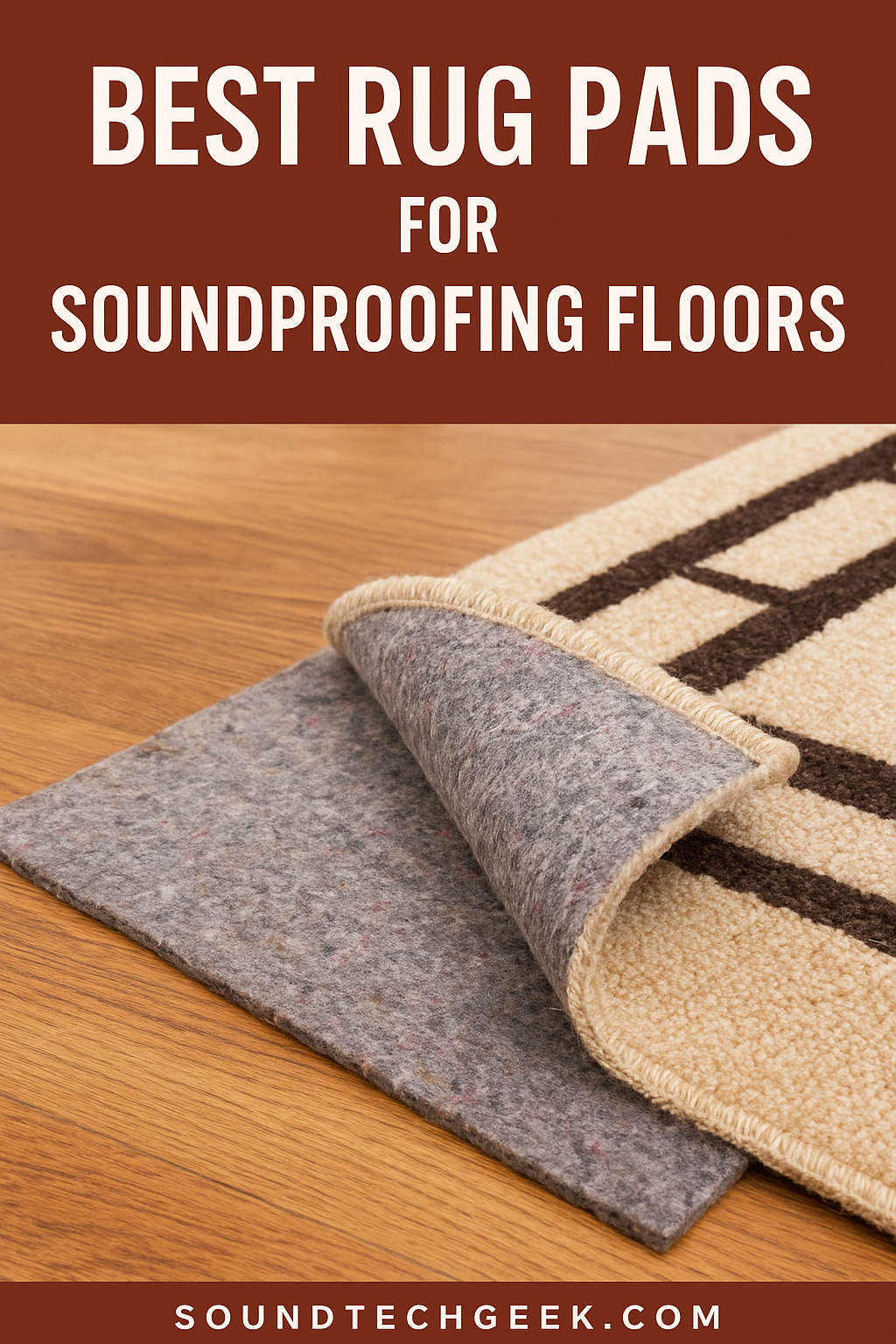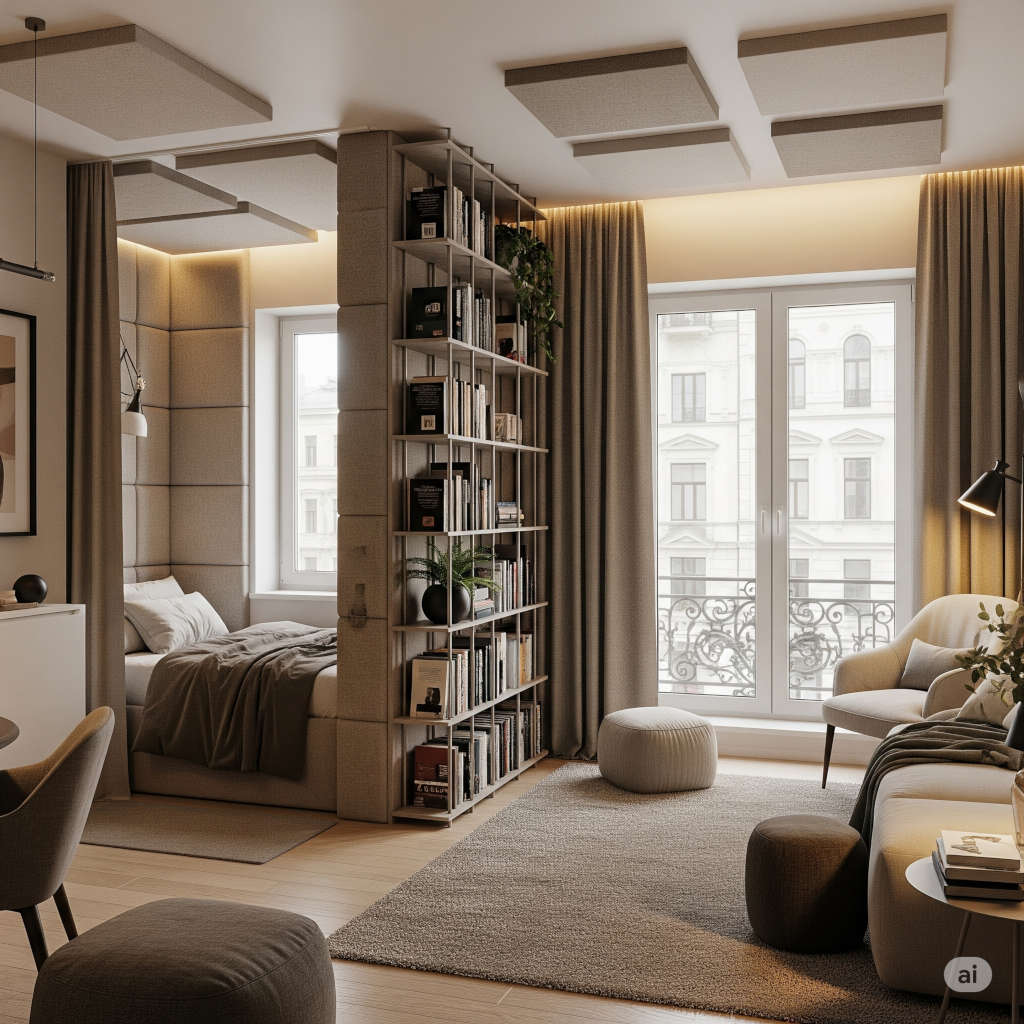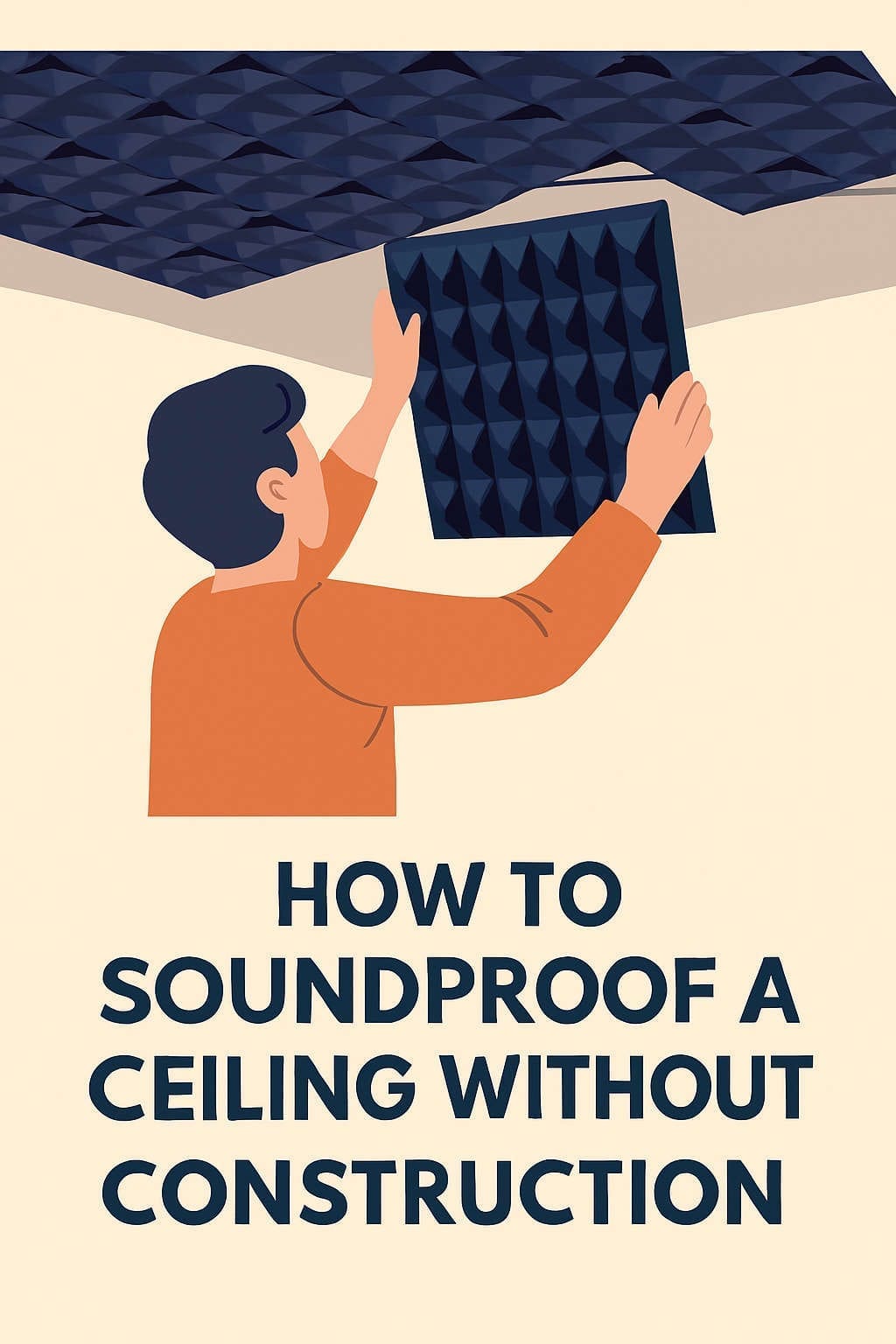Walk into a sparsely furnished room with bare floors, minimal textiles, and wide, empty walls, and you’ll notice something immediately: sound lingers. Every word you say bounces back at you, every step echoes longer than it should, and the space feels strangely hollow, even uncomfortable. Now imagine walking into a cozy living room where thick curtains hang gracefully, a plush sofa sits surrounded by throw pillows, a large rug anchors the floor, and leafy plants soften the corners. The same conversation suddenly feels warmer, calmer, and easier to follow.
That difference comes down to sound absorption—the way a room’s design and furnishings interact with sound waves. Most of us don’t think about acoustics until we encounter an issue, whether it’s a noisy apartment, an echoey office, or a home theater that doesn’t sound as crisp as it should. Yet, without tearing down walls or installing expensive professional panels, you can dramatically improve the way your rooms sound simply by making thoughtful décor choices.
This guide will walk you through the science of sound absorption, why it matters, and—most importantly—how you can use everyday décor elements to create a space that is not only beautiful but also acoustically comfortable. By the end, you’ll see your rugs, curtains, plants, and even bookshelves in an entirely new light.
Sound Absorption vs. Soundproofing: Clearing the Confusion
Many people use “soundproofing” and “sound absorption” interchangeably, but they are not the same thing. Understanding the difference helps set realistic expectations for what décor can (and cannot) do.
- Soundproofing means preventing sound from entering or leaving a room. If your neighbor’s music keeps you awake, or if you’re worried about disturbing others while practicing guitar, you need soundproofing. Achieving it often requires construction-based solutions—extra insulation, heavy drywall, sealed doors, and sometimes specialized materials.
- Sound absorption, on the other hand, deals with sound inside a space. Think of it as taming echoes and reducing reverberation. Instead of bouncing endlessly from one hard surface to another, sound waves are absorbed by softer, porous, or textured materials.
Décor cannot make your walls impervious to outside noise, but it can transform how pleasant a space feels acoustically. That’s the focus of this article.
Why Acoustics Shape the Atmosphere of a Room
Sound influences how we experience a space just as much as light, color, and layout. A restaurant with too much echo can feel chaotic. An office where every keystroke and phone call ricochets becomes exhausting. A living room with bare walls may look stylish in photos but feel strangely uninviting in person.
When sound isn’t properly absorbed, conversations become harder to follow, television dialogue feels muddled, and even background noise from appliances becomes more intrusive. Conversely, a room with good sound absorption feels calmer. Voices are clearer. Music has depth without harshness. The atmosphere seems warmer, more intimate, and more welcoming.
So, creating an acoustically balanced home isn’t just a technical pursuit—it’s about comfort, mood, and even well-being.
The Science of Sound and Surfaces
To understand how décor helps, it’s worth a quick detour into the science of sound. Sound travels in waves. When those waves encounter a surface, one of three things happens:
- Reflection – The sound bounces back, like an echo in an empty hallway.
- Transmission – The sound passes through, like a muffled voice through a wall.
- Absorption – The sound gets trapped and dissipates, often as heat within porous materials.
Hard, flat materials like glass, metal, and polished concrete reflect sound. Soft, fibrous, and textured surfaces absorb it. The trick to improving acoustics through décor is introducing more of the latter into your room—layering fabrics, textiles, and irregular surfaces that soak up or scatter sound.
Turning Décor Into Acoustic Allies
When people think about improving acoustics, they often imagine bulky foam panels or industrial-looking treatments. But in reality, almost every decorative choice you make has an acoustic impact. Here’s how common décor elements can quietly (and stylishly) transform your space.
Rugs and Carpets: The Unsung Heroes of Quiet Spaces
Bare floors, whether hardwood, tile, or laminate, are notorious sound reflectors. Adding a thick rug changes that instantly. A high-pile or shaggy rug doesn’t just soften the look of a room—it absorbs mid- and high-frequency sounds that would otherwise bounce around unchecked.
Layering rugs, using extra-thick padding underneath, or choosing wall-to-wall carpeting in certain rooms (like a home theater or bedroom) can multiply the effect. Even smaller area rugs placed strategically under seating areas reduce the echo where conversations happen most often.
Upholstered Furniture: Comfort Meets Function
A sofa is more than a place to sit—it’s also a sound absorber. The thicker and softer the upholstery, the more effective it is. Plush armchairs, fabric ottomans, and cushioned benches all contribute. Compare the feel of a room with sleek leather furniture to one filled with deep velvet or linen-upholstered seating. The latter not only invites you to sink in but also softens the acoustics dramatically.
Choosing upholstered furniture is one of the most effective (and natural) ways to reduce echo without making your space look like a recording studio.
Curtains and Drapes: Acoustic Barriers in Disguise
Windows are double trouble when it comes to acoustics: they both reflect sound and allow outside noise to filter in. Hanging heavy curtains does wonders. Velvet drapes, wool blends, or even layered curtains with a blackout lining can absorb a surprising amount of sound.
For best results, let them fall from ceiling to floor and extend beyond the width of the window. This way, you’re covering not just the glass but also some of the wall, creating a soft vertical surface that counteracts reflections.
Wall Hangings and Tapestries: Art with a Purpose
Bare walls act like amplifiers. Hanging textiles—whether woven tapestries, quilts, macramé, or fabric art—interrupts that reflective surface. These pieces not only add character and warmth but also absorb and scatter sound.
Even a framed canvas painting helps, though fabric-based art works best. Some people build their own acoustic art panels by wrapping thick fabric around wooden frames filled with insulation material. The result looks like a painting but functions like a sound sponge.
Bookshelves and Storage: A Natural Sound Diffuser
Bookshelves full of novels, decorative boxes, and unevenly arranged items create an irregular surface that breaks up sound waves. Instead of bouncing back clearly, sound scatters in different directions, reducing harsh echoes.
A tall bookshelf along a shared wall can also provide a subtle sound barrier against noise from neighbors. Think of it as stylish insulation.
Plants and Greenery: Nature’s Acoustic Enhancers
Plants aren’t just for aesthetics and air quality—they also absorb and scatter sound. Large, leafy varieties placed in corners or grouped together along walls can noticeably soften a room’s acoustics.
Broad leaves, fibrous stems, and even the soil in a pot all contribute to diffusing sound. A tall fiddle-leaf fig or a cluster of rubber plants in a living room doubles as an organic “sound wall.”
Acoustic Art Panels and Designer Solutions
In recent years, manufacturers have created sound-absorbing panels disguised as décor. These might look like modern art prints, geometric wall tiles, or fabric-wrapped sculptures, but inside they’re designed specifically to absorb sound.
For those who want a polished look without DIY, acoustic art panels strike the perfect balance between style and function.
Ceiling Treatments: Tackling the Forgotten Surface
In rooms with high ceilings, echo often comes from above. Draping lightweight fabric overhead, adding wooden beams with insulation between, or installing acoustic ceiling tiles can reduce reverberation. Even pendant lights with fabric shades make a small difference.
Treating ceilings is especially valuable in home theaters, music rooms, or open-plan living spaces with lots of vertical height.
Small Details That Add Up
Sometimes it’s the little things that make the biggest difference. A pile of throw pillows on the sofa, a chunky knit blanket tossed over a chair, or even a fabric room divider can collectively soften the way sound behaves. Layering these smaller items throughout the room builds acoustic comfort without feeling intentional or staged.
Creating Harmony Through Layering
The real secret to maximizing sound absorption with décor isn’t choosing one magic item—it’s layering. A single rug may help, but pair it with curtains, upholstered furniture, wall hangings, and plants, and you transform the entire acoustic environment.
Think of your space as an orchestra. Each decorative element is like an instrument: alone it plays a small part, but together they create harmony. When textiles cover the floor, fabrics soften the windows, furniture adds bulk, and greenery fills empty corners, the room becomes acoustically balanced.
How Placement Changes the Game
Even with the right décor, placement matters enormously. Sound builds up in corners, bounces most aggressively off large flat surfaces, and often reflects from unexpected directions.
Placing plants in corners, hanging fabric art opposite reflective surfaces like windows, or positioning bookshelves along problematic walls ensures your décor isn’t just decorative—it’s strategic.
For example, in a home theater, placing panels or heavy drapes on the wall behind the seating prevents sound from bouncing back and muddying the experience. In a bedroom, a cushioned headboard absorbs reflections that would otherwise disturb sleep.
Room-by-Room Acoustic Styling
Every room has different needs when it comes to acoustics.
- Living Room: This is often the most echo-prone space, especially if it has large windows or an open-plan design. Combining area rugs, heavy curtains, fabric sofas, and tall plants creates a warm, conversation-friendly atmosphere.
- Bedroom: Since comfort and quiet are the priorities, thick curtains, an upholstered headboard, rugs by the bed, and soft bedding all contribute to a cocoon-like feel.
- Home Office: Acoustic comfort here improves concentration. A large bookshelf, wall art panels, and a couple of leafy plants can make work-from-home sessions far more pleasant.
- Home Theater or Media Room: This is where layering becomes essential. Wall-to-wall carpet, ceiling panels, fabric-covered seating, and thick drapes deliver cinema-quality sound.
Mistakes People Often Make
One common mistake is expecting one element—say, a rug—to solve all problems. Sound absorption is cumulative; it works best when multiple surfaces are softened. Another mistake is choosing shiny, sleek materials like silk or leather, which reflect rather than absorb. And too often, ceilings and corners are ignored, even though they’re acoustic trouble spots.
Finally, some people worry that focusing on acoustics will ruin their aesthetic. In reality, today’s options—from velvet sofas to decorative panels—show that style and sound absorption can go hand in hand.
DIY Ideas for Budget-Friendly Improvements
If you’re handy, there are creative ways to build your own sound-absorbing décor. Wrapping fabric around a frame filled with recycled denim insulation creates an effective wall panel. Layering curtains with blackout liners is another affordable fix. Even a corkboard wall, covered with fabric, can double as a pinboard and acoustic solution.
These projects allow you to customize colors and textures, blending them seamlessly into your décor while enhancing sound quality.
When Professional Help is Needed
Décor can transform everyday spaces, but sometimes you may need professional intervention—particularly for music studios, high-end home theaters, or offices where clear communication is critical. Acoustic consultants can design precise treatments tailored to your room’s dimensions and use. Often, the best results come from blending professional solutions with thoughtful décor choices.
Final Thoughts: Living in Spaces That Sound as Good as They Look
We often think about how rooms look but rarely about how they sound. Yet acoustics shape our daily experiences more than we realize. A room filled only with reflective surfaces may look chic but feel cold and unwelcoming. Add layers of texture, softness, and thoughtful décor, and suddenly the same space feels inviting, calm, and easy to inhabit.
Maximizing sound absorption with décor doesn’t require sacrificing style. Quite the opposite—it encourages richer, cozier interiors that feel alive and comfortable. Whether you’re quieting a city apartment, creating a restful bedroom, or designing a home theater, the choices you make in rugs, curtains, furniture, plants, and art all contribute to how your space sounds.
Ultimately, the best rooms are those where beauty and comfort meet—where the design pleases the eye and the acoustics soothe the ear. With the right décor, you can create that balance in your own home.
You might also like,
- How to Sew Linen Curtains: Easy DIY Guide + Save $200+ Per Window
- Top 7 Apartment Noise Problems and Smart Solutions for a Quieter Home
- Best Door Sweeps & Draft Stoppers for Soundproofing | Quiet Home Guide
- How to Soundproof Your Home on a Budget: DIY Tips That Actually Work
- Mass Loaded Vinyl: Complete Guide to What It Is & How to Install It for Noise Control
